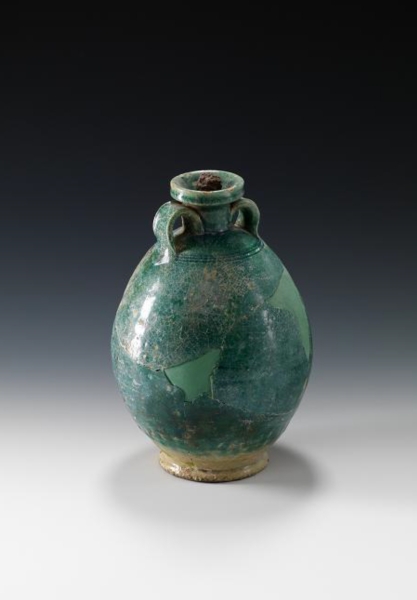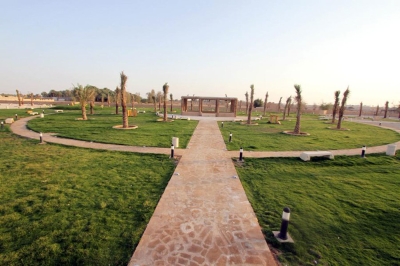
The Green Ceramic Jar is crafted from yellow clay and shaped like a pear. It was discovered at Qaryat al-Faw Archaeological Site, one of the richest Saudi historical sites. This site was inhabited by al-Faw civilization, which flourished and maintained close ties with other kingdoms. It is located at the intersection of Wadi ad-Dawasir and the Tuwaiq Mountain Range in southeastern Wadi ad-Dawasir Governorate in Riyadh Province, Kingdom of Saudi Arabia.
Description of the ceramic jar
The green ceramic jar features a narrow, short neck that ends in a mouth with outward-projecting lips that then curve upward. It has two small ear-shaped handles attached to the upper part of the body just below the neck and a low ring base with a thick edge. Its outer surface is coated with a green glaze cracked in several areas, while the base has a darker green glaze. Most of the lower section of the base has lost its glaze layer.
Dimensions of the ceramic jar
Outer mouth diameter: Five cm.
Base diameter: ten cm.
History of the ceramic jar
The green ceramic jar dates back to the period between the third century BCE and the third century CE. It was used for storing liquids.
The ceramic jar is housed at the Museum of the Department of Archaeology at King Saud University in Riyadh. It was previously selected as one of Saudi Arabia’s historically significant archaeological discoveries to be featured in the Saudi Archeological Masterpieces Through the Ages Exhibition. By 2023, this exhibition had toured major museums in eleven countries across Europe, the United States, and Asia, attracting significant media attention for its rare artifacts that highlight the importance of Saudi Arabia's civilizations and historical heritage. The artifacts related to Saudi heritage encompassed various aspects, including social, cultural, and economic fields.
The discovery of the green ceramic vase is among the findings of archaeological surveys and excavation efforts conducted by the antiquities and museums sector in Saudi Arabia over the past years. It is the result of the efforts of Saudi archaeologists, scientific expeditions, and joint research teams. The jar is registered under number 26 F 17.
Significance of the ceramic jar
The design of this vessel, with its green glazing, indicates an influence from the styles prevalent in Mesopotamia during the Parthian period.
Related quizzes
Related articles

